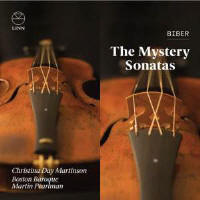Texte paru dans: / Appeared in: |
|
|
Reviewer: Michael
De Sapio
Most Baroque violinists sooner
or later try their hand at Biber’s Mystery Sonatas. They are an extremely
difficult set to pull off, however, both technically (the extreme demands of
the scordatura tunings) and from an interpretative point of view. The most
successful versions balance an awareness of the sonatas’ programmatic
content with an elegant musicality—a crucial balance, without which Biber’s
set becomes two hours of bizarre histrionics for the violin. In this regard
nobody can beat John Holloway, whose 1989 recording with Tragicomedia
remains my gold standard. This new version featuring the Canadian violinist
Christina Day Martinson strikes me as overactive and under-effective. There
is a tendency to scrape and chop up the musical line; Biber’s individual
moments don’t always connect into coherent larger phrases. The continuo
group becomes heavy-handed in some places: Everybody goes well beyond the
call of scene-painting duty, for example, in the “Crucifixion”’s earthquake.
In other places, the momentum flags or the affect seems uncertain (the
opening of the “Scourging” sounds inappropriately cheerful).
Of little help is the close-up
recorded sound (was this a live performance?), which gives a shrill edge to
Martinson’s tone, and the tuning, a mishmash leaning too heavily toward
equal temperament for my taste. I would also question some stylistic
niceties, such as Martinson’s beginning her trills from the upper
note—generally a no-no in Biber—and reproducing some faulty notes in the
facsimile.
I have always thought that,
generally speaking, the main descriptive thrust of each of the Mystery
Sonatas is contained in the introductory movements, and that one can “relax”
and produce a more decorative and elegant music-making in the themes and
variations. Too much intensity produces an overworked effect. Martinson and
her colleagues are certainly dramatic enough, but a quality of spiritual
radiance is missing. Interestingly, the scordatura tunings of the violin’s open strings are played before each sonata; I am not aware if any other recording has done this. A lot of work clearly went into this recording, but I’m afraid it’s a misfire. Better to stick with the versions already on offer, especially John Holloway’s. | |
|
|
|
|
|
|
|
Cliquez l'un ou l'autre
bouton pour découvrir bien d'autres critiques de CD |
|




